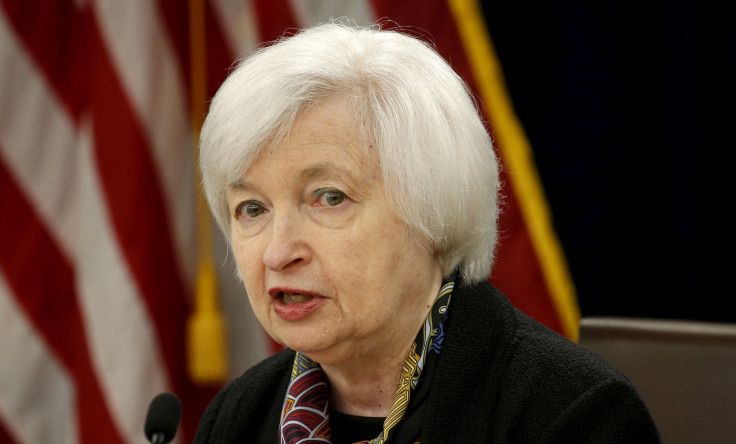Fed Officials Are Signaling A June Rate Hike, But Not Everyone Is Convinced

As Federal Reserve officials look ahead to their mid-June meeting, central bankers have shared a sunnier view of the American economy, nodding toward a potential interest rate hike next month.
Yet outside the Fed’s favorite data points — employment numbers and inflation — the picture for the U.S. economy is far murkier. Unemployment, while at a healthy 5 percent, hasn’t budged in six months, and measures of labor slack like part-time employment have stagnated. Corporate profits are set to decline for a third straight quarter, while global demand remains unsteady.
“The Fed has had a much more optimistic forecast of the economy than the economy has delivered,” Steven Ricchiuto, chief economist of Mizuho Securities USA, said. “That continues to be the basic underlying difference between where Wall Street is seeing them and where they are.”
A chorus of Fed officials has added momentum to a June rate hike this week. “If the data comes in and it's not consistent with my view of the strength in the economy, then I would pause,” Philadelphia Fed President Patrick Harker said Monday. “But otherwise I think a June rate increase is appropriate.”
“There's no reason to prejudge June,” St. Louis Fed President James Bullard told CNBC, indicating that the Fed could raise the top benchmark interest rate from 0.5 percent to 0.75 percent next month.
That message, combined with a surprisingly upbeat view seen in minutes from the Fed’s April meeting, have pushed investors’ expectations up for a rate hike. At the beginning of the month, markets implied a mere 4 percent chance that the Fed would tighten monetary policy in June. Now markets show 1-in-3 odds that the Fed will move.
That disconnect hasn’t been lost on Fed officials. “The markets are certainly more pessimistic than I am,” Dennis Lockhart, president of the Atlanta Fed, said earlier this month.
On Friday, the Fed’s message could get another boost, with the release of revised gross domestic product data from the first quarter of the year. The first pass of the data showed GDP growth of just 0.5 percent, a measly gain for the first three months of the year and an unsettling sign for broader economic growth. Now Wall Street is expecting that number to rise up to a somewhat less worrying level of 0.9 percent.
“The 0.5 number never made much sense,” said Ricchiuto, who expects GDP growth to be revised up to 1 percent. “That’s just the way the data has come out.”
Better-than-expected inventory data and consumer spending for the first quarter have raised analysts’ expectations. But those data also reflect unevenness in the business climate, particularly around inventories.
“Revenues are falling for a lot of businesses, and they end up with a lot of extra inventories,” Robert King, senior economist at the Jerome Levy Forecasting Center, said. “But those inventories have to come down, and that creates a sense of weakness.”
Large swings in commodities prices have complicated the Commerce Department’s task of estimating inventory levels and, by extension, GDP growth. So the picture there remains clouded. “We are seeing a turn in the inventory cycle,” King said, adding that manufacturing has also underwhelmed expectations. “Those combined can mean some very sharp weakening underlying in the U.S. economy.”
But business conditions tend to occupy a peripheral role at the Fed, whose mandate centers on inflation and employment. Corporate profits, for instance, have sagged for six quarters straight — the longest stretch of declines outside of a recession.
Still, the headwinds that battered financial markets at the start of the year are now in the rear-view mirror. The dollar’s strength has come down, giving export-heavy industries a boost. And despite a dip in payroll gains in April, employment levels largely weathered the financial turmoil of January and February.
“We’ve seen a turnaround,” Commonwealth Financial Network Chief Investment Officer Brad McMillan said, pointing to firming consumer spending and acceleration in wage growth. “You add that all up, and you might see some positive surprises in the rest of the year.”
McMillan sees a rate hike in July as more likely than one in June, given uncertainty around the upcoming referendum in the U.K. about leaving the European Union. “The Fed very much wants to start raising rates, but I think the uncertainties around June might be too much. Waiting another month makes sense,” McMillan said.
But not everyone is convinced the Fed has sufficient economic justification for moving forward with a rate increase in June, which would be the first in a year that the Fed originally expected to see four rate hikes. “They’ve been trying to normalize rates since June of last year,” Ricchiuto said. “Now they’re finding excuses for themselves.”
© Copyright IBTimes 2024. All rights reserved.






















